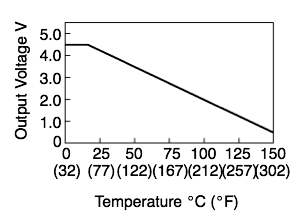
| Part 1: Overview; tires/brakes | |
| Part 2: Underhood | |
| Part 3: Headlights: the Big Schnoz | |
| ==> | Part 4: Inverter pump |
| Part 5: Coolant testing | |
| Part 5b: Engine coolant | |
| Part 6: Transaxle / driveline, references |
|
One increasing concern comes from tales in the forums, all about Priuses
reaching about this age and having the inverter coolant pump fail. It's a
small electric pump that runs all the time and is possibly not quite up to
the long-term task asked of it, as discussed in
this analysis, so when it fails the
inverter assembly and motors can lose significant cooling capacity. The usual
result is the Triangle of Doom and greatly reduced motive power from the
car, most often on hot days, but fortunately this isn't a permanent condition
as there are several thermal safeguards in the system and once it has cooled
back down to sane levels, functionality is restored for a while.
Being rather attentive to the sights and sounds around me where cars are concerned, I realized just from a subtly changed running noise that my own pump was beginning to wear out, almost right on schedule somewhere a little past 100,000 miles. It is possible that mine had a few extra hours on it relative to the car's mileage anyway, as I've spent my share of days with the hybrid system powered up and running to keep some 12V accessories or an AC inverter alive while I answer questions, run demos, and hand out flyers at energy-fests and transportation events. That has put hours on the pump with zero distance, and it wears at the same rate whether the car's rolling or not. Therefore I became a bit concerned about complete pump failure and rising inverter temperatures happening while I was going somewhere, and decided at the very least that for the short term I should be able to monitor the temps in some way. |

|
The inverter provides two thermal output signals from its power transistor assemblies, one for each of the racks driving MG1 and MG2 which undergo some very different loading conditions during operation. These signals are not NTC thermistor response curves as for the engine coolant, but are electronically configured to produce voltages that inversely relate to temperature in a vaguely similar fashion. These outputs are more linear and use different scaling, but I figured the easiest thing to do would be to switch them to the same "ECT linearizer" circuit input and just get a relative reading on the meter -- that would be good enough to warn of overheating, without necessarily needing to know the exact running temps. |

|
The wires come up to the back of the meter selector rotary-switch and the other half of the dividers which then tie to a ground point. The dividers bring the inverter-temp outputs into a sort of mid-level range for the display circuit, causing the normal nice-weather running temps of roughly 50C to indicate about 5V on the meter. |
|
The actual temp figures can be crosschecked from the hybrid ECU with a
scantool, but aren't necessary to have available all the time. [The
Scangauge community hasn't managed to program Xgauges to monitor any of
these temps via CAN, which could have shortcut a lot of this analog-side
work, but there are some showstopping network protocol issues.] Some testing
was done to determine where the meter reads when temps start rising high enough
to get concerned about, which made for a fun mess of wires and meters hanging
out of the dash for a day or two and a nice demo I took to a local cruise-in
night in the process of running the data-logging.
It was basically there that I discovered that the car could sit powered up with the magic mystery wire that feeds the pump completely disconnected, and that the inverter can dissipate that very low standby load through its own metal mass without the coolant flowing. [See abovementioned analysis for description...] It's always fun to have gearhead muscle-car enthusiasts come by and talk about inverters and ECUs and electric motor control. Which they actually do surprisingly often. When they get curious enough to stick a beefy, tattooed arm down in there to feel the inverter pump running and understand what it's for, you know you've got them thinking a little differently, maybe just for a few moments, before they wander back over to their beloved fire-breathin' iron. | |
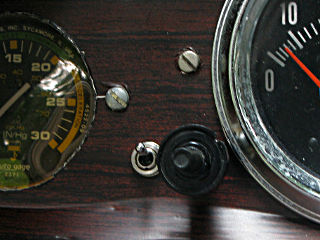
|
ECT tap <----o===>o------./\/\/\/`----+-./\/\/\/`-------.
switch 470 ohm `----^ _|_ gnd
5K pot ///
As long as I had the gauge panel pulled out for modification, it was an
opportunity to add another little hack I'd been thinking about for a while.
The existing engine-coolant thermistor tap got a small add-on circuit to
manually fake a higher engine temperature as the car sees it, allowing earlier
transition into stage 4 operation and staying in it during minor engine
cooldowns. There's a
Priuschat thread
all about this and why it's nice to have.
This one uses a 470-ohm limiter to avoid driving the faked-out coolant temp
so high that the overheat warnings go on, and the 5K pot gives a larger range
of control which is useful during cold-weather startups.
|
|
Instrumentation enhancements aside, bottom line is that before too long
the inverter pump simply has to be replaced anyway and preferably *before*
it actually fails hard. This means draining the inverter coolant loop,
which also provides the opportunity to refill it with fresh stuff as coolants,
even in relatively light duty, don't last forever either. Once the new pump
and a gallon of Toyota SLLC are in hand, the job is actually fairly easy.
There are several threads and blog entries, on Priuschat and elsewhere, reflecting other peoples' experiences with pump replacement that are well worth reading for supporting/background material. See the references section. There is a definite observable trend toward more "failures" in hot climates like summers in Arizona and Florida. It is possible that some owners have driven around with a failed or dying pump for quite some time in cooler weather, without triggering the overheat warnings! The stories are a mix of DIY and dealer-service, and hopefully providing much more in-depth detail here will encourage more people to handle this repair themselves and save quite a bit on the labor. The inverter can be thought of as something like a really big stereo amp, with enough passive heatsinking around its drivers to handle a nominal load without doing anything extreme, but where one might want to add a fan blowing air over a set of fins for higher-power operation in warm environments. That's sort of what this pump provides -- that extra bit of heat removal. |
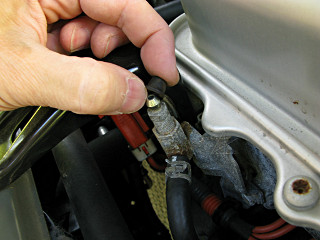
|
The inverter coolant system has a bleeder for removing air, attached to the front of the inverter. Its hose actually feeds down to the top of the transaxle as shown about midway down the maint50k page. |
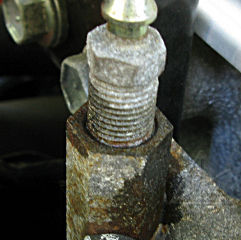
|
The bleed fitting is sort of corroded, so a little WD-40 goes onto its threads to soak in for a bit while we're doing other prep work. |
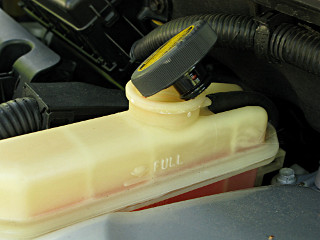
|
The coolant will drain much better if the reservoir cap is off to let air into the top of the system. |
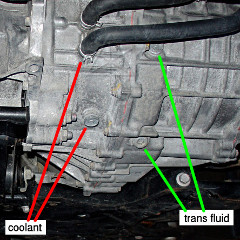
|
Let's review which fluids go where in the transaxle here. This time we're going after the coolant side. |
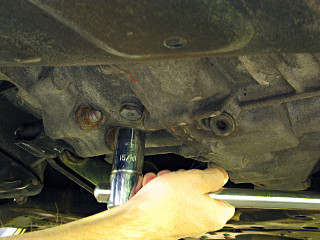
|
Time to get a wrench onto the drain plug and crack 'er loose. |

|
The coolant is much less viscous than transmission fluid, and starts drooling out around the plug threads immediately. We want to have the catch container under there before loosening. |
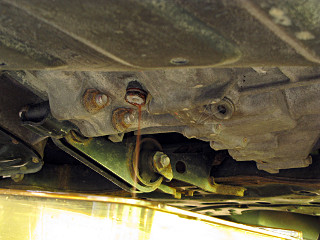
|
But as the coolant level starts dropping a little and air begins audibly gurgling its way into the inverter passages, a thought occurs. Rather than simply drain it, how about capturing some of the important sounds that are used to indicate success of proper filling procedures? So the plug stays mostly in to just allow a a slow trickle, and I go power up the car to IG-ON to spin the pump. The camera has a sort of laughable sound recorder built into it, which nonetheless may be good enough to capture what happens as more air enters the system and the pump eventually runs dry as the level sinks below its little impeller. |
Play this sound file and follow the timetable below:
| |
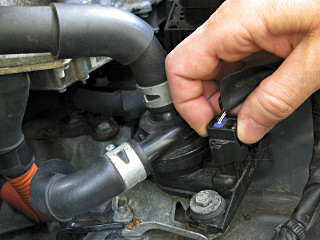
|
Sometimes the pump power connector is a little hard to remove; squeezing the release tab carefully with needlenose pliers instead of fingers may help. |
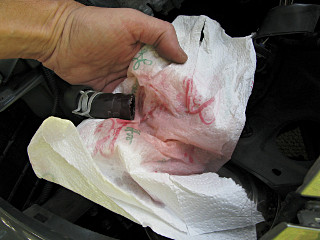
|
The top hose that runs across the top of the radiator goes down and then up again forming a little valley, and still has a bit of fluid sitting in it. |
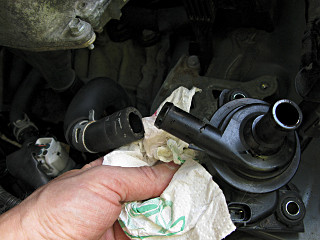
|
The lower hose is no problem, since it only goes down from here and that's been all drained out already. |
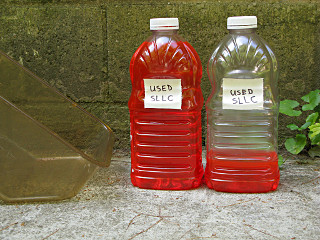
|
How much coolant came out all told? Eyeballing these 64-ounce bottles says
about 2.4 or 2.5 quarts. Dry spec is 2.9 quarts, so there is possibly
just shy of a pint left inside the system.
Ironically, the spec for coolant capacity is listed nowhere I could find in the '04 or '06 service information PDFs at hand. I eventually found it in my Bentley book. |
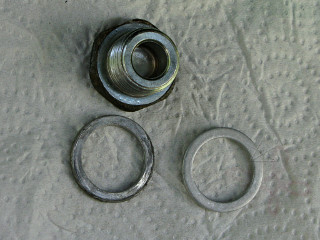
|
Plug washers, old and new. |
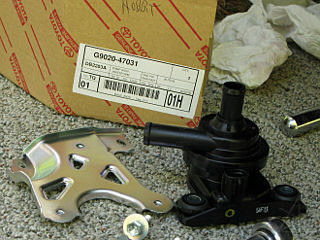
|
The theory is that the new pump is somehow an improved model. A copy of the
Toyota TSB on it is here, where it is finally
admitted that there might have been a design deficiency. I can see and feel
no particular difference between them other than a very slightly different
molded contour in the casing near the outlet pipe; the new one rattles
internally about as much as the old one when shaken.
It will clearly be easier to mount the new pump onto the old bracket, and this way Steve at Autobeyours [who supplied me the new pump in the first place] gets back an extra brand-new non-mangled bracket out of it to use in his collision repairs. |
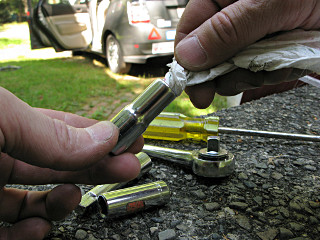
|
After working around coolants, it's good to clean off the tools and get rid of that weird all-over slippery feeling. |